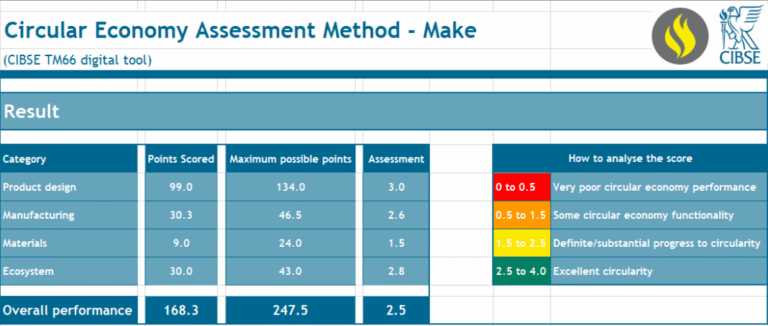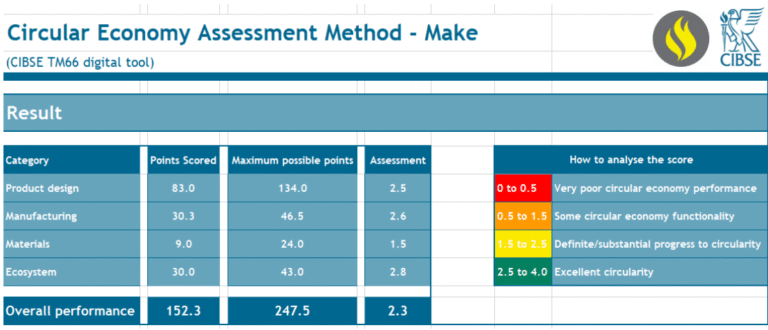
Lighting Designed for Circularity: TM65 & TM66 in Practice
TM65 & TM66 Assessed Luminaires
Real, assessed luminaires only. One series is visible by default; switch between families to compare TM66 circularity and TM65 material composition.
—
Rating: —TM66 Circularity (CEAM pillars)
Design for Disassembly · Material Efficiency · Sustainable Manufacturing · End-of-Life Strategy
TM65 Material Composition
% by mass (Aluminium / Electronics / Plastics / Other). “Other” auto-calculates to reach 100%.
| Material | % by mass |
|---|
Compare with another series
—
—

The results from CIBSE’s CEAM digital tool shows the Eco 78 scoring ‘excellent circularity’
Circular Lighting and the Future of Sustainable Design
The lighting industry is moving rapidly toward a circular economy model — one where luminaires are designed not just for performance, but for longevity, repair and re-use. CIBSE’s TM66 Circular Economy Assessment Method (CEAM) and TM65 embodied carbon framework are at the heart of this shift, giving manufacturers and specifiers a common language to measure sustainability beyond simple energy efficiency.
At its core, TM66 evaluates how a luminaire supports circularity through design, material selection, manufacturing practices and end-of-life processes. It considers factors such as the ease of component replacement, recyclability of materials, local sourcing, and documentation transparency — all essential for a truly sustainable product.
TM65 complements this by calculating the embodied carbon associated with a luminaire’s materials and production. Understanding embodied carbon is becoming critical for architects, engineers and sustainability consultants aiming to achieve BREEAM, LEED and Net Zero targets.
How Lumenloop Applies TM65 & TM66 Principles
Every new Lumenloop luminaire is developed with these standards in mind. Our products are designed and manufactured in the UK within a 250-mile supply chain, reducing transport emissions and supporting local industry. Modular components — such as LED engines, optics and drivers — can be replaced or upgraded, extending the usable life of the fitting while minimising waste.
The luminaires featured above have been formally assessed to TM66 Excellent, demonstrating the benchmark level of circularity we aim for across our range. These include high-efficiency aluminium housings with up to 98% recyclability and easy disassembly at end of life — practical examples of how circular lighting design translates into measurable environmental benefit.
Why Circular Lighting Matters
Lighting accounts for a significant share of a building’s embodied and operational carbon. By applying TM65 and TM66 frameworks, designers can quantify those impacts and make informed decisions on product selection. Circular lighting design reduces resource consumption, simplifies maintenance, and supports compliance with the UK’s evolving sustainability standards such as CIBSE TM66:2021 and the Construction Product Declaration framework.
As building projects shift toward whole-life carbon assessment, the role of circularity becomes even more important. Selecting luminaires that can be serviced, reused or recycled ensures that the lighting system remains efficient and adaptable throughout the life of the building — not just at installation.
Practical Takeaways for Specifiers
- Ask for TM65 and TM66 data — it’s the clearest indicator of product transparency and circular design integrity.
- Prioritise modular luminaires — replaceable drivers and optics reduce embodied carbon and extend system life.
- Choose local manufacturing — a shorter supply chain minimises transport emissions and supports regional resilience.
- Document circularity — using TM66 results in project specifications helps safeguard against value engineering.
These steps make circular lighting measurable and defensible, providing tangible value to clients, contractors and sustainability assessors alike.
Moving Toward Fully Verified Circular Lighting
Lumenloop is expanding its TM66 and TM65 programme across all luminaire families. As new assessments are completed, they will be added to this page, allowing designers and facilities managers to make evidence-based choices for sustainable lighting solutions. The goal is simple — to create lighting that performs brilliantly today while remaining repairable, recyclable and resource-efficient tomorrow.

Natura 125’s TM66 scorecard (LED panel)